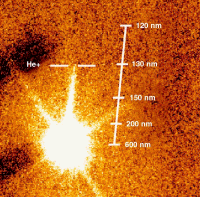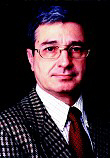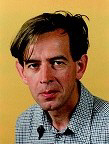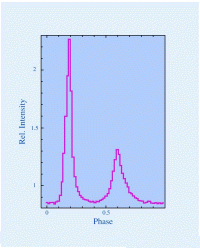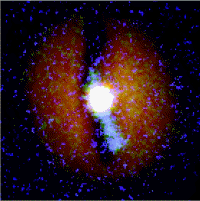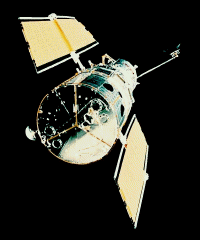Hubble: Europe's share
A long-sought fossil gas found at last
The first big find with the refurbished Hubble came early in 1994 from ESA's Space Science Department at Noordwijk in the Netherlands. There Peter Jakobsen led a team hunting primeval helium gas. In the theory of the Big Bang, helium was a key product and it supposedly influenced the subsequent history of the Universe.
Figure 3. Helium cut-off in ultraviolet. HST (NASA & ESA) FOC P. Jakobsen et al.
The helium should exist far out in cosmic space and reveal its presence by blocking much of the ultraviolet light from quasars in extremely active and distant galaxies. But hydrogen in intervening clouds usually frustrates the attempt to see distant helium.
The team found a chink in the clouds in front of Quasar 0302-003. A prism in the Faint Object Camera then created a simple spectrum. It revealed the long-sought helium by an abrupt cut-off in the spectrum at 130 nanometres, seen in the picture. The discovery of the helium and its proven ionization (by the loss of an electron) were seen as breakthroughs in cosmology.
"It was like trying to spot stars through breaks in the clouds," Peter Jakobsen explained. "In our case the cloud cover spans most of the observable Universe."
Figure 4. Red and blue stars in the Spindle galaxy. HST (ESA & NASA) WFPC2 medium deep survey
At Cambridge University, Rebecca Elson hunts "fossil stars" that formed when the Universe was young. They lurk in faint haloes that surround galaxies, or in compact swarms called globular clusters. In Hubble images of nearby galaxies, Elson noticed that some fossil stars were the wrong colour. Being redder than others in the same galaxies, they might be more enriched with metals, and were perhaps born later than their bluer companions.
She confirmed two eras of ancient star formation, in two distinct sets of globular clusters in M87, a bloated, stormy galaxy with a spectacular jet coming from it. In the isolated and apparently normal Spindle Galaxy, she found two similarly distinct populations in halo stars The redder, perhaps younger, stars may signal a catastrophe - possibly a major collision with another galaxy.
The history of stars and galaxies helps in understanding how our own Milky Way Galaxy established and preserved the conditions for life.
|
|
|
|
Rebecca Elson | |
|
|
"Working with Hubble images is a great privilege," Rebecca Elson said. "What fun, to see fine details in the Universe that no one ever saw before! And we always have to be ready for the surprises that teach us something new."
At Basle University in Switzerland, Gustav Tammann uses the Hubble Space Telescope to measure the Hubble Constant - the rate at which the Universe expands.
Sixty years ago another Swiss astronomer Fritz Zwicky noted that certain supernovae, stellar explosions seen in other galaxies, were "standard candles" that could measure relative cosmic distances. In 1979 Tammann proposed that the Space Telescope should fix the distances of the nearer galaxies showing the right kind of supernovae, by looking for variable stars (Cepheids). The more remote supernovae would then tell the distances of their host galaxies, and the galaxies' speeds would reveal the expansion rate.
Two teams of astronomers began working on this task when Hubble was launched in 1990. Tammann himself enrolled in one of them. At first, the teams' answers were contradictory, but he was undaunted.
|
| |
|
Gustav Tammann | |
|
|
"We're approaching a decisive moment in cosmology," Gustav Tammann commented in 1999. "I've waited twenty years for Hubble's verdict on Hubble's Constant, so I can be patient till we have a consensus. Our own observations are wonderfully consistent."
Nature's own lenses extend Hubble's range
Curious arc-like streaks appear among the cluster of galaxies called Abell 2218, as seen by the Hubble WFPC2 camera. The streaks are far more distant galaxies, up to eight billion light-years away. They would normally be too faint to see, but the strong gravity of the cluster of galaxies acts as a natural telephoto lens, focusing their light.
In 1993, a team led by the British astronomer Richard Ellis found lensed galaxies in another cluster (AC 114) using Hubble. Two years later, in the scene shown above, the team found more than a hundred features that are gravitationally imaged.
The natural lens is clumsy. Its images are distorted and multiplied. But Jean-Paul Kneib, a French scientist in Ellis's team, used the distortions to deduce the distances of the imaged galaxies.
European Coordinating Facility
To enable European astronomers to make the best use of Hubble, ESA joined with the European Southern Observatory (ESO) in creating the Space Telescope European Coordinating Facility. It is located at ESO's headquarters at Garching in Germany.
Garching is in daily touch with Baltimore, Maryland, where the Space Telescope Science Institute oversees Hubble's scientific operations. Fifteen ESA scientists work full-time in Baltimore.
The expert team at ST-ECF Garching helps astronomers to propose observations to be made with Hubble.
ST-ECF also holds at Garching a complete copy of the Hubble archives. With more than 200 000 images and spectra now freely available to all comers, European scientists are beginning to find the archives a gold mine.
|
| |
|
Piero Benvenuti | |
|
|
"The Space Telescope is a very complex machine," remarked ESA's Piero Benvenuti, who is charge of the Garching facility. "Careful planning of the observations is not only required, but can considerably enhance the science outcome. Between 1990 and 1998 we offered help to over 400 successful proposals from Europe, leading to almost 20 000 observations made so far."
The long history of the chemical elements
At Hamburg Observatory, Germany, Dieter Reimers leads a team of astronomers who want to know how and when the Universe acquired stocks of chemical elements, heavier than the primeval hydrogen and helium. With instruments on the ground and in space they trace the origin, through cosmic time, of elements like carbon, silicon and iron, from which planets and living things can be built.
The team analysed ultraviolet light from distant quasars, using first the IUE spacecraft and then the Faint Object Spectrograph on Hubble. On its way from the quasar to the Earth, the light passes through various intervening galaxies and gas clouds, like the skewer of a kebab. Each object visited absorbs some of the quasar light, depending on the local abundance of the elements.
|
| |
|
Dieter Reimers | |
|
|
"We see quite rapid element-making when the Universe was young," Dieter Reimers said. "Then the stocks built up progressively through time, by the alchemy of successive generations of stars."
Supersight for the 21st century
A foretaste of futuristic astronomy came in 1999, when a superconducting camera looked for pulsars - pulsating neutron stars - with the UK's William Herschel Telescope in Spain's Canary Islands. This was the first astronomical test for a novel light detector developed by ESA. Ideal for seeing the dim, quick flashes of the pulsars, or other faint objects like very distant galaxies, such ultra-sensitive cameras may become standard equipment for the great observatories.
Figure 6. Light from Crab pulsar. From ESA STJ camera at WHT (UK, La Palma)
ESA's Space Science Department at ESTEC leads the world with its superconducting sensors called STJs. Cooled to a temperature below -270°C to achieve superconductivity, STJs can serve a huge range of wavelengths, from X-rays to infrared light.
When even a single particle of light (photon) hits an STJ it gives a precisely timed and strong signal, by releasing thousands of electrons. The electron count depends on the wavelength, so an STJ camera provides highly accurate colour information too.
|
| |
|
Didier Martin | |
|
|
"We're thinking about world-beating detectors for what comes after the Hubble Space Telescope, and for X-ray astronomy missions after XMM," said Didier Martin, a Belgian physicist-engineer in the Astrophysics Division. "On the ground, we use liquid helium to cool a camera to the low temperature we need. A mechanical cooler would be preferable in space, so we're also working to tame the vibrations that could spoil the view."
Last updated: 24 March 2000
The first naked black hole in a galaxy
In 1997, a scientist examining Hubble images at the European Southern Observatory at Garching, Germany, was elated. Philippe Crane discovered the very first plain view of a giant black hole powering a stormy galaxy, not masked by the usual swirl of obscuring dust.
Figure 1. Core of Galaxy NGC 6251. HST (NASA & ESA) FOC and WFPC2 P. Crane
Galaxy NGC 6251 lies 300 million light-years away in the Ursa Minor constellation. Even at that great distance, ESA's Faint Object Camera on Hubble saw fine detail down to 50 light-years, in the core of the galaxy. Crane and his colleague Joel Vernet were rewarded with an amazing scene.
A blaze of ultraviolet light came directly to the camera from the immediate vicinity of the black hole. This stupendous lamp also lit a nearby segment of a warped disk of dust.
"It blew my mind away," Philippe Crane commented. "This is a completely new phenomenon revealed by the Hubble Space Telescope - thanks to the extremely high resolution in the ultraviolet given by ESA's Faint Object Camera."
Finding the mysterious black holes helps to confirm the basic physical laws of the Universe, and to explain how galaxies evolve, including the Milky Way where we live.
Figure 2. Hubble after 1993 refurbishment (NASA)
The most famous space telescope of them all is Hubble, a project of international cooperation between NASA and the European Space Agency. NASA's role is well known, but how many people appreciate Europe's contribution?
ESA developed the Faint Object Camera, one of the main imaging instruments, and provided the solar panels powering Hubble. ESA staff based in the USA and Germany help to plan and interpret the observations.
When Hubble was launched in 1990, the telescope was defective. European astronomers taught their American colleagues how to "deconvolute" poor images and extract information. By their upbeat attitude during the difficult years, they made possible a stream of early discoveries and consolidated Europe's role in the programme.
A memorable space shuttle mission in December 1993 corrected Hubble's eyesight. NASA's astronauts were assisted by ESA's Swiss astronaut Claude Nicollier, and Europe was ready to help to reap the benefits.
Because of ESA's contribution, scientists in Europe are guaranteed 15 percent of Hubble's observing time. By submitting excellent proposals, the Europeans have always exceeded that allocation by a non-trivial margin, and have made a fine intellectual contribution to Hubble's scientific successes.

